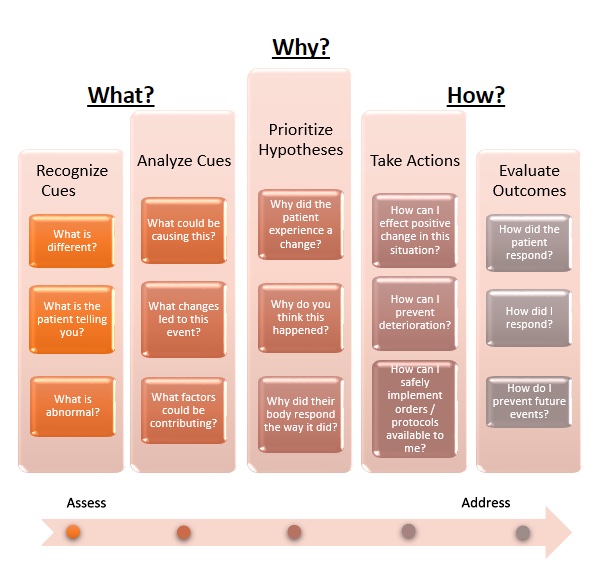Clinical judgement is the big buzz in nurse education right now. Rightfully so. The NCSBN’s Next-Gen Clinical Judgement Measurement Model (CJMM) is the new standard that will move us forward in safe clinical practice. According to research from the NCSBN, nursing students lack clinical judgement, the cornerstone of safe practice.
According to Hoffman, “The two most common reasons that new graduate nurses are disciplined are (1) failure to notice changes in patient status and (2) failure to act when a patient is deteriorating.” This is a sobering report. How can the CJMM help students and newly licensed nurses enter their career with confidence and competence? The answer is curiosity.
The second layer of the CJMM comprises five aspects of clinical judgment: recognize cues, analyze cues, prioritize hypotheses, take actions, and evaluate outcomes. These components, when addressed in an orderly fashion, can help the nurse make better clinical decisions. I propose that we ask ourselves three simple questions to lead us through this model: What? Why? How?
The questions What? and Why? lead us through assessment. The question How? leads us to address our findings.
What? This question can help us make a quick determination of whether a patient’s status has changed and if it calls for a response. This is where you can recognize a cue from your patient—for example, a change in level of consciousness, a report of new or worsening pain, or a change in skin color that differs from an earlier assessment. You’ll then continue with the question by analyzing the cues. If the patient has new chest pain, for example, what could be causing it? What changes led to it? What other factors might you consider? These questions of analysis will lead to the next question: Why?
Why? This question helps us propose and then prioritize hypotheses or nursing diagnoses. What hypotheses are you considering for this patient with acute chest pain? Changes in perfusion, like in acute myocardial infarction or pulmonary embolism? Changes in oxygenation, like in a chronic obstructive pulmonary disease exacerbation or acute bronchospasm? You must consider the possibilities and then distill these back through the first two steps of recognizing and analyzing. Why did this patient experience this change? Why did a physiologic change occur? What were the cues? Then onto the How.
How? This is where the implementation of clinical judgment gets legs. I tell students that one leg is knowledge and one is experience. One without the other could leave you standing still. According to Hoffman and colleagues, new nurses frequently receive discipline because they fail to act. You must question the significance of your assessments and then address your findings through action. How can you respond to the change in your patient with nursing actions or with the safe implementation of available orders or protocols? Once you’ve addressed your patient’s needs, then you can evaluate your work. How did your patient respond to the treatment you chose? How did you respond to your own plan? How do you think you can prevent this problem from occurring again while the patient is in your care?
The identification of the gap in clinical judgement invites an opportunity for students, educators, and all nurses to evaluate processes and practices of inquiry. Learning this method, like any other, requires repetition and intention. You can make better choices when you ask better questions. Whether you’re a student, a staff nurse, or an educator, I hope that the What? Why? How? of clinical judgment will help you as you continue forward in your nursing career. Keep learning. Stay curious!
Megan Pittman, DNP, APRN, FNP-C
References
Hoffman JJ, Sullivan NJ. Foundations for medical-surgical nursing. In: Davis Advantage for Medical-Surgical Nursing: Making Connections to Practice, 3rd ed. Philadelphia, PA: F.A. Davis Company; 2023.
National Council of State Boards of Nursing. Clinical judgement measurement model. nclex.com/clinical-judgment-measurement-model.page.


















